
The Battle of Heligoland was fought on 9 May 1864, during the Second Schleswig War, between a Danish squadron led by Commodore Edouard Suenson and a joint Austro-Prussian squadron commanded by the Austrian Commodore Wilhelm von Tegetthoff. The action came about as a result of the Danish blockade of German ports in the North Sea; the Austrians had sent two steam frigates, SMS Schwarzenberg and Radetzky, to reinforce the small Prussian Navy to help break the blockade. After arriving in the North Sea, Tegetthoff joined a Prussian aviso and a pair of gunboats. To oppose him, Suenson had available the steam frigates Niels Juel and Jylland and the corvette Hejmdal.
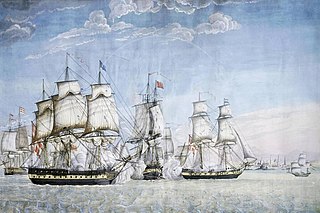
The Action of 16 May 1797 was a naval battle that took place near Tripoli in Ottoman Tripolitania. The Danish squadron was attacked by a Tripolitan squadron that outnumbered them in number of vessels.

Jens Schou Fabricius was the Norwegian appointed Minister of the Navy 1817–1818. He served as a representative for Søe-Deffensionen at the Norwegian Constitutional Assembly at Eidsvoll in 1814. During his naval career he served first the Danish-Norwegian Crown until the separation in 1814 of Norway and Denmark, and thereafter the Norwegian-Swedish Crown. Fabricius retired from the navy as a vice admiral.

Frederik Christian Kaas was a Danish naval officer and landowner. He served as the governor of the Royal Danish Naval Academy from 1770 to 1781.

Steen Andersen Bille, was a Danish vice-admiral and minister for the navy. He was famous for his service in the Danish Royal Navy, particularly during the First Schleswig War, 1848–1851.
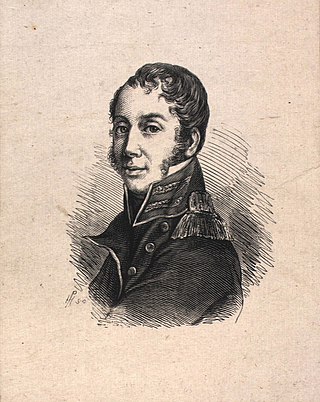
Hans Peter Holm was a Danish naval officer who commanded vessels of the Dano-Norwegian Navy in several actions. He commanded several naval vessels during the Gunboat War. His most important action occurred in 1812 at the Battle of Lyngør when a British squadron, led by the British ship-of-the-line HMS Dictator, destroyed his vessel, HDMS Najaden. Holm sustained wounds in the battle but survived, only to drown in an accident shortly afterwards.
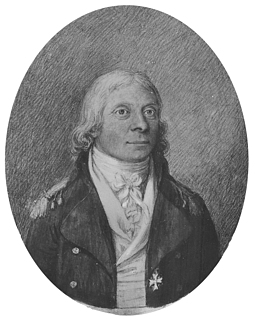
Lorentz Fisker (1753–1819) was a Danish naval officer who charted the waters of southern Norway and the Kattegat, and organised Norwegian defences against Britain and Sweden.
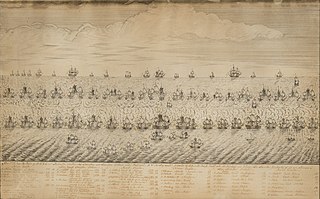
Battle of Rügen was a major naval battle fought on August 8, 1715 off Jasmund on the Swedish island of Rügen during the Great Northern War.
Andreas Lous was a Danish naval officer responsible for early navigational charts of Danish Waters and the dredging of harbours, in addition to sea-time on various Danish warships. He was captain of the ship-of-the-line HDMS Printz Friderich when she ran aground in 1780 near Læsø and was a total loss.
HDMS Friderichsværn was a Danish frigate built at Nyeholm, Copenhagen, in 1783. The British Royal Navy captured her in 1807 and took her into service as HMS Frederickscoarn. It sold her in 1814.
Henrik Lorentz Fisker was a successful naval officer in the service of Denmark. He was the son of an attorney at the supreme court, and deputy mayor of Copenhagen. From the age of thirteen as a cadet in the Danish-Norwegian navy, he rose through the ranks to vice admiral in 1775 and full admiral in 1790. He died 20 June 1797 and was buried in the Holmens Kirkegård, the Danish naval cemetery, in Copenhagen.
Andreas Schifter (1779–1852) was a Danish naval officer and shipbuilder, a capable naval administrator and admiral. He oversaw the transition of the Danish navy from sail to early steam power.

Daniel Ernst Bille was a naval officer and rear admiral in the service of the Danish crown.

Frederik Christian Kaas (1725–1803) was a naval officer and admiral in the service of the Danish-Norwegian Crown.
Olfert Fasvier Fischer was a naval officer in the service of the Danish crown who became a director of the Danish Asia Company and completed his career as a vice admiral.
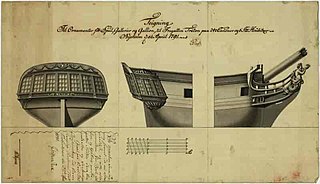
HDMS Triton was a Danish frigate launched in 1790 which operated in Danish/Norwegian home waters and in the Mediterranean in the protection of Danish merchant ships - not only from Barbary pirates but also from potential British privateers. The period in which it operated was fraught with political and practical difficulties which led to two battles at Copenhagen and other, lesser, actions.

Ulrik Christian Kaas, a member of the old noble family of Mur Kaas, was a Danish naval officer who rose to the rank of admiral.

HDMS Justitia was a 72-gun ship of the line of the Royal Dano-Norwegian Navy built to a design by Henrik Gerner. Although launched in 1777, she was not fully commissioned until 1780. The Royal Navy captured her together with most of the Dano-Norwegian navy after the battle of Copenhagen in 1807. The British never commissioned Justitia. A renaming to Orford in 1809 was cancelled. She was broken up in 1817.

Mercurius was a paddle-wheel steamer, built in the United Kingdom in 1828. The ship was ordered by the Royal Danish Mail Service in Copenhagen and was employed on the postal and passenger service on the Great Belt between Korsør and Nyborg. In 1856 she was sold to Joseph Owen & Sønner in Copenhagen and in 1864 she was acquired by Oscar Petersen with the name Robert. Removed from the ship list in 1867.
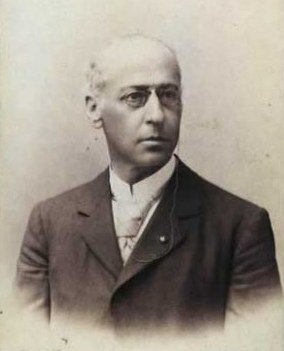
Edouard Suenson was a Danish naval officer who served as managing director of the Great Northern Telegraph Company from 1877 and later as chairman of the board.



















